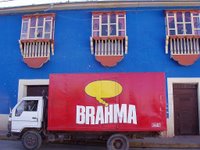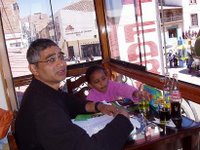15th September, Friday - Up at 5:30am on a very cold morning. Maxima brought breakfast to the room to help out, and we were picked up at our hotel at 7.30. We left our bags at the hotel, taking only a single backpack with us. We would return to stay a night in Puno, after the night on the island.

At the port we met Maria-Lisa, a Peruvian girl who loved Indian (hindi) movies and wanted to learn hindi. Our guide for the Island trip was Juan, a self assured man who could speak many languages. We were seventeen in the group , mainly a young lot in their early twenties; 6 art students from Paris, 2 from Ecuador on some project work, 3 from Montreal, 2 NGO volunteers from Germany, one from San Francisco and us three.

Today we would visit the Uros floating islands first and then onto Amantani to spend the night there. The next day we would visit the island of Tequile; all these are on Lake Titicaca. Lake Titicaca is the highest lake in the world, nearly 300 metres deep, and more than 8500 sq.mts. in area. There is a Peruvian side and a Bolivia side to the lake. More than 60% is on the Peruvian side - something Juan was very proud to note.

The boat took us an hour to get to the Uros islands. There are more than forty of these man-made floating islands made entirely (layer upon layer) of a kind of reed, called Tortora - grown in abundance in the shallows of lake Titicaca.

This reed is a source of food and the basic material building the island, for house roofs, walls and fishing rafts - thus the island and everything on it is a pale yellow straw colour. The Uros Indians have lived like this for over 600 years, trying to avoid more dominating & powerful neighbours. Now there are only a few hundred living on the islands, most of which are a mixture of the original Uros and the larger Aymara tribe. The Incas considered the Uros to to be very, very poor and did not tax them.

They (the Uros) are not very much better off today. They live a hard life and have to go long distances to find fresh water - the men spend time fishing & the women making handicrafts & knit sweaters. They still have to go to the mainland to trade their goods for meat, vegetables and other needs as nothing can be grown on the soil-less island.

The bottom of the island rots rapidly so they also spend a great deal of time adding a new layers at the top. Thanks to the last Peruvian president, Fujimori, they have solar power now for limited electricity. They also depend on the tourists that visit their islands. More than half the islanders have converted to Catholicism though they still follow their old traditions.

We had a very interesting visit - felt absolutely wierd walking on a floating island. There was a talk by our guide and the Island chief about the local customs and traditions and the islanders had handicrafts for sale. A young boy, who said he was 6 years old, but looked four, helped with pulling our boat in, and tying and untying the boat ropes.
From the Uros Island we took 3 hours to get to Amantani. It was wonderful to be on a boat, on Lake Titicaca. The water was a deep, deep blue colour and the clear blue sky with a mirror like reflection so strong, that we all had to wear sunglasses and sun cream to protect the eyes and skin.

The time was great for getting to know the others on the boat - the French art students were very polite and interesting, especially Maxim who had a permanent smile and just got along with everyone. Lila was a Chinese American, who was very well travelled and especially easy to talk to. She had even spent time in India learning yoga - she also learned to play snakes-&-ladders from Letay. Priscilla, from Ecuador, was a business student but also studied dance, which was obvious in her graceful movements and poise. She spent a lot of time in Cuba with her dance studies too.

Amantani Island, a basket weavers's island, is the largest on the lake (about 20 to 30 km across) which still maintains a degree of cultural isolation and have control over the toruist trade. The ancient Inca agricultural terraces are very well maintained and the Inca labour and ritual laws and the traditional stone masonry is still practised.

The Amantani islanders eat mainly vegetables and meat is rarely eaten. They keep sheep and pigs but have no cattle for milk. There are no roads on the island, though the walking paths run through the entire island. There is also absolutely no electricity on the islands (although street lamps were installed). We were advised, very wisely, by Victor the tour operator, not to take any chocolates, sweets, pens or paper to the Islands - these were typical tourist "gifts" which were not practical. We instead took fruit & milk, which were essential and not available on the island. We also took some reading books for the children.

On getting to Amantani we had a steep walk up to the point where the islanders, whose houses we would be staying in, had gathered to welcome the tourists. Each of us were allocated to a family (about 2-3 per family) by the village elder. The local people were all dressed in their colouful traditional clothes that they normally wore to go out. We met Theodosis, the lady of the house we would be staying at, which luckily was not far from the meeting point - although she initially teased us saying that she lived right near the temple on the hill. We were very impressed with the house; to us it looked like the best in the village.

It was made of mud bricks, had a stone fence, a swing gate leading to the house, a neat little garden with flowers. The kitchen, store rooms and the toilet were on the lower level around a small courtyard and the two bedrooms and a big balcony on the upper. The kitchen, looked the oldest and was not part of the main house but at the side within the courtyard. We were surprised that the house had a toilet, although a very basic one - possibly a result of the tourist invasion.

The room we got was more than we had expected, clean and big with enough beds and blankets. Deepa had been very worried by stories that it would be freezing on the island that she had made sure that the tour company had given us a sleeping bag; we surely did not need it !! As there was no electricity on the island, there were candles in the room. After sunset the island is completely dark and it is very difficult to walk and find one's way around on moonless nights and tourists have been heard to have lost their way on many occasions.

Once we were shown our room, Theodosis went straight to the kitchen to prepare lunch. Rossini spent a lot of time in the kitchen with her asking about island life. In her family they were three; her husband, Feliciano who was away in Puno trading and selling and her ten year old daughter - Florita, who was at school then. She would be back by 3.00 pm.

The kitchen was surely the warmest and most lived in part of the house with the wood stove fire going all the time. In here there was the table at one side neatly laid with wooden benches to sit around, with the open wood-fire traditional stove for cooking on the other side. The ceiling was black with soot and the place was smokey most of the time during the cooking. However it was very cosy in there.

We had a rather late lunch but a wholesome one consisting of Salad, very nourishing Soup made of Quinwa (a kind of cereal grown since Inca times) and vegetables and potatoes - extremely tasty and very welcome in the cold. We finished it off with Munya tea - Munya is a very fragrant leafy herb, found only in the higher regions of the Andes. We were all very satisfied especially Letay who loves Quinwa soup. Florita was back from school by then and had joined us for lunch - she was very shy but Rossini kept her busy (& distracted) with his questions.
After lunch there was a trek organised to the top of the hill to visit the Pre-Inca (900 year old) temple there and watch the sunset. Letay was just not in the mood to walk (climb rather), so just Rossini went for the trek.

Florita walked up to the meeting point with Rossini. She too dressed up in her traditional clothes. This meant wearing the multi-layered skirt over the basic one and putting on a very colourful shawl over. The walk was especially tiring for Rossini (after the great lunch), climbing a few hundred metres above the high altitude we were already at.
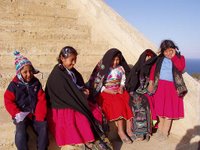
Florita stayed back at the meeting point with the other children who had brought their guests too, whilst Rossini and the rest climbed to the top to visit the Pre-Inca Temple, which was now a meeting point for the young courting boys and girls of the island. When back to the meeting point Rossini found that Florita was super hot and tired from the games she and the other children had played.

Meanwhile Letay fell asleep and Deepa read and watched the sunset from the balcony of the house. The lake looked fabulous... dark blue and peaceful. When Rossini returned dinner was being prepared. We could not think of eating again after the late scumptious lunch. Anyway we sat and chatted with Theodosis in the kitchen while she cooked. It was really cold and windy outside and and getting darker, with dark clouds rolling in too. We were not keen to go for any more walks especially the fiesta in the town hall (also uphill !!)organised for us the visitors. We ate dinner which was brilliant soup again, made of Trigo (wheat) and rice, potatoes and carrots.
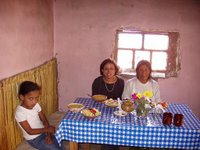
Theodosis mentioned that this was the normal diet - Quinwa soup for lunch and Trigo soup for dinner. We, especially Letay & Rossini, had lost a lot of weight with the generally healthy diet in Peru and with the huge doses of trekking (mainly uphill). During dinner Rossini asked Theodosis about how she and Feliciano met - she very shyly, almost blushing, described their love-at-first sight meeting, when they were nineteen. She was around forty now but looked much older with the wear of a hard life and the weather.

It had begun raining and we decided against going for the fiesta and also because Florita was obligated to take us there and back. Theodosis was quite pleased too that we decided against the night walk. It was pitch dark outside and the lighting looked spectacular. We did not stay up late - went to bed watching the lighting through the windows.
16th September, Thursday - It was wonderful to wake up early and watch the sunrise, on an island in the middle of lake Titicaca miles away from any traffic or noise. There were no cars or roads on the island anyway.

It would certainly be a great education for a lot of children to see how life was possible with only the most basic of things - no electricity, no TV, no shops or streets, - and in turn appreciate what we have elsewhere. We certainly enjoyed being allowed to be a part of Theodosis & Florita's lives albeit for a day. Some of the other people in our group could not communicate completely with their hosts as they spoke no spanish only Quechua.......and others did not want to communicate, so stayed in the rooms coming out only for the meals.

We ate pancakes for breakfast and drank lots of Munya tea, and then were escorted by both Theodosis and Florita back to the boat. It was a bit of a walk down to the jetty but downhill was no effort. We were almost at the boat when Rossini realised that he had forgotten his hat in the house. Having this well-worn (well travelled) and loved hat around for over 16 years, he was not going to leave it behind. He had to walk uphill all over again and he was breathless & hot by the time he got back to the boat. Unfortunately, after the boat left the island, one of the French students realised that his passport was left behind on the island. We had to turn around and he had an even more difficult run up hill to get his passport - the entire boat cheered when he got back.

The boat then took us to the next island of Taquile, which has been inhabited for over 10,000 years, with agriculture being introduced here around 4000 BC. It has been through periods of rule by the Tiahuanaco (speaking Aymara) and then the Incas (speaking Quechua). It came under Spanish rule when it was bought (??? from whom) by Pedro de Taquile. The island is around 1km by 7km and looks a bit like a whale, with all the ribbed terracing around it.

We docked on the more gradual side of the island, and walked slowly with Letay the hour and a half to the top; the Town centre. Letay was in tears much of the way up, not because it was a breathless climb but more so because we were the last. The view along the way and especially the deep blue waters of the Titicaca were brilliant. It is amazing how little development has come to this island, quite a bit out of choice.

At the town centre, Juan gave us a brief talk on the hand woven textiles of this island, which it was famous for. One man from the village modelled the garments as Juan explained them to us. Most of the 1200 inhabitants are weavers and knitters of fine Alpaca wool. Locals "drop-spin" the yarn, which produces a very fine thread. Men wear black woolen trousers with a bright woven waistband, like matadors, white coarse linen shirts with long pleated sleeves, a black waistcoat and a very characteristic red hat. The women wear layered skirts and a blouse and a black scarves with shocking-pink or red trimmings.

We all then sat down to a soup and trout meal, on the terrace overlooking the lake. It was quite a spectacular day and by then everyone was quite familiar with each other. Rossini embarrased a very quite french boy who had the kindest face and most piercing eyes by telling him that he would make a great model if Rossini ever wanted to paint a picture of Jesus. From then onward, he was called Jesus by the rest.

We then made our way down the steeper part of the Island, down 525 steep steps. Even the decent was quite tiring and we saw some locals climbing up, carrying furniture (beds, mattresses, cupboards).

Our boat had come around the island to pick us up at the bottom of the stairs.

On the way back to Puno we stopped at one of the floating Islands, where the two Ecuadorians got off to spend the night there. The boy was a student of Architecture and was writing a paper on the structures of these islands. We all wished him and Priscilla the best as we knew that accomodation here was very basic and that night temperatures dropped below zero.
Got back to Puno quite tired. The group had to split up as we were picked up from the port in small vans. "Jesus" was in our van away from his group and he had no clue where he was staying, nor even the area......not even the layout of Puno, and he only spoke French. He was noticeably quite worried. So after we were all dropped off, Rossini took him back to the Tour office, and found out where the French group were staying and got "Jesus" back to his fold. There were a few jokes about "Jesus losing the way" and "finding Jesus". Nevertheless, Rossini later received a thank-you email from him saying how grateful he was.
It felt good being back at the Hotel. Maxima and Senora Magda too made us feel welcome and were all interested in what we did on the island. After freshening up, we met Lila and Natalie (from Montreal) for dinner. Our favourite restaurant was shut, so we just ate at another one that open. Went off to bed early, knowing we had another early morning, needing to be at the bus-stop at 7:30am to catch a bus for Copocabana (Bolivia). Maxima promised to get us an early breakfast to the room again.

This was our last night in Peru, a country that we would love to come back to. Of all the places, we would want to come back to Cusco and just stay a long time. Rossini would seriously like to make it a base to study Spanish and do some voluntary work. Peruvians to us were warm, friendly and very down to earth people. They were gentle but certainly not weak people, their lives and character shaped by the mighty Andes. We did not ever come across a voice raised in anger nor did we see any form of violence, or a whinge about anything, not even the weather. Everywhere you feel the richness of the past empires and traditions that covered these lands and this too lends the people a great sense of pride. With our experiences in Colombia and Peru, it seemed that South America was taking over our hearts.
THANK YOU PERU !!!!
The rough plan at present for Bolivia was Copocabana, La Paz, Potosi, and then Uyuni, trying to get into Chile either over the great Salt Lakes, or bypassing the Salt Lakes - all in a matter of 12 to 14 days. We were unsure at this point if we could also include Oruro and Sucre.
 Dana went with me to Machi Picchu. She was very happy there. She liked the Mountains and the Inca. She did not like the climb. She did not see any gold there.
Dana went with me to Machi Picchu. She was very happy there. She liked the Mountains and the Inca. She did not like the climb. She did not see any gold there.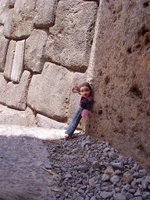 This was Dana in Saxsaywuman (ed: Sacsayhuaman). Dana loved the Inca buildings and there rocks. She was very tiyed (ed: tired) walking. She cud (ed: could) see the whole Cusco city from the top.
This was Dana in Saxsaywuman (ed: Sacsayhuaman). Dana loved the Inca buildings and there rocks. She was very tiyed (ed: tired) walking. She cud (ed: could) see the whole Cusco city from the top. Dana sleept on the Amantani Iland (ed: island) at night. This was on lake titicaca. She liked the Munya tea and Qinwa soup.
Dana sleept on the Amantani Iland (ed: island) at night. This was on lake titicaca. She liked the Munya tea and Qinwa soup. Dana went to the Uros floating islands. She made lots of friends on the Uros. The boats and the islands are made of reeds. She met ten kids. They worked and went to school on the uros island.
Dana went to the Uros floating islands. She made lots of friends on the Uros. The boats and the islands are made of reeds. She met ten kids. They worked and went to school on the uros island. Dana loved the inca kola in Peru. She loved the taste. She was happy in Peru because she saw lots of golds and silver.
Dana loved the inca kola in Peru. She loved the taste. She was happy in Peru because she saw lots of golds and silver.





































